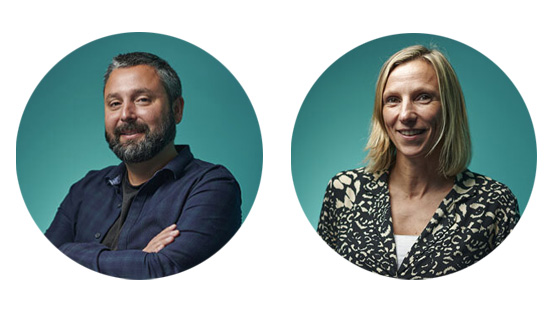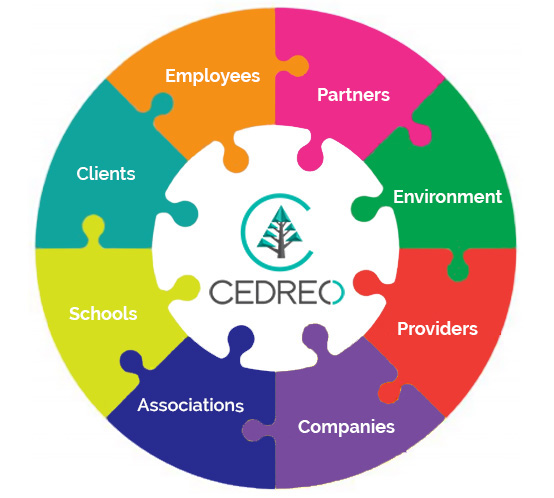A mission-driven company is a commercial company that incorporates a social or environmental objective in its statutes. This notion was introduced by the PACTE Law in 2019 in France and is above all a commitment made by the company. By defining its raison d’être, which is intended to become the backbone of the company, it puts in writing the major orientations that will guide its strategy and determines the objectives that will be associated with it.
By June 2021, 200 companies had chosen to adopt a mission statement. Today, there are nearly 800, and Cedreo has just joined the club of these committed companies.
"Empowering people to build better environments" is what Cedreo is all about.
We asked Mickaël Keromnes, CEO and Marie Van Goethem, VP Ops, a few questions about the stakes involved in these few lines added to the company’s statutes.

Why was it important to you that Cedreo became a mission-driven company?
MK: Milton Friedman said in 1970 that the purpose of a business is to increase profits.
That was 50 years ago and we believe that things have changed today. Our conviction is that in the 21st century companies need to be globally efficient. It must certainly generate profits, otherwise there is simply no company, but it must also take into account its externalities, its ecosystem, in order to be sustainable.
By becoming a mission-driven company, we want to set this as a long term goal. This balances our governance by systematically questioning the trade-off between profit growth and our externalities. In practice, we now have a mission committee that includes stakeholders who challenge the management committee on the impact of its choices and their alignment with Cedreo’s mission.
What are the objectives of this transformation?
MK: I don’t know if we can call it a transformation. Overall performance is in Cedreo’s DNA. We are more in a continuous improvement process here.
The objective is not to oppose profitability and impact, but rather to move towards a global performance of the company: sustained and sustainable growth. We have experienced sustained growth, but we can do better on sustainability. By structuring our mission on several axes (internal team, clients, environmental and societal impact, governance) we give clear guidelines to Cedreo’s strategic choices and action plans.
One risk we have identified is that we may have our heads in the sand too much and lack open-mindedness, pragmatism or simply be biased in our decisions. This is why we believe that integrating stakeholders from outside the company as well as experts in this committee will benefit us
What are Cedreo’s commitments?
MVG: Cedreo has made ambitious but achievable commitments that impact its employees, partners, and customers, as well as the surrounding community and the environment. Here are the commitments written into our statutes :
– Provide the tools and knowledge for our employees to evolve in an environment that allows them to express their potential at Cedreo and in their future careers.
– Measure and reduce Cedreo’s environmental impact, including reducing CO2 emissions faster than the targets set in the Paris agreement.
– Accompany its clients towards autonomy and more responsible and sustainable construction choices.
– Take into account the needs and constraints of all its partners to provide them with a healthy and balanced work environment.
– Contribute to the development of the territories in which Cedreo operates by, among other things, providing tools and sharing knowledge with people of the territories concerned.
– Exchange feedback to help accelerate the implementation of impact actions.

How do you assess that the mission is "fulfilled"?
MVG: There are several ways to get an objective assessment of our mission.
The first is the creation of a mission committee that includes actors from outside our company. And of course the implementation of internal monitoring indicators (the rate of CO2 emitted by transport, the eNPS that we do not want to see fall below 60,…)
These indicators are also precious to follow our efforts on a daily basis and not to wait for the final audit to get the result.
And in concrete terms, how can a company become a mission-driven company?
MVG: First and foremost, I believe it is essential to have a CSR approach that is already well established in the company’s culture before embarking on the exercise. It is much simpler in this context and this was the case at Cedreo.
Then, you have to focus on what makes sense for the employees and what you can really have an impact on.
From there, we identify the major themes and reflect on ambitious, realistic and concrete commitments that are also sustainable over time.
The last step consists of validating everyone’s adherence to this commitment: we have chosen to publish the proposal internally, in particular to our impact committee.
For once, the administrative part is perhaps the simplest of the steps: all that is needed is to add a new sub-paragraph (2.1 Purpose) in article 2 (Object) of the statutes and to describe its purpose followed by its commitments. The new articles of association are then filed with the clerk of the commercial court.
How does being a mission-driven company change your day-to-day business?
MK: It doesn’t really have an impact on the level of activity but more on the strategic choices and especially their implementation. We wanted our missions to be concrete and explicit enough so that they would not remain just ideas but they would be clear objectives.
In concrete terms, this has practical impacts when, for example, we want to expand internationally while reducing our carbon impact. It brings some constraints that can be circumvented with a little thought and pragmatism. In practice, we have managed to reduce our carbon impact per person in spite of opening two new countries.
And what are the consequences for the employees?
MK: Here again we are more in a continuous improvement process. While we have allocated time (6 days/year per person) and resources (1% of the turnover), the question is to make these resources efficient. We started by better organizing our approach by relying on the B Corp label, which was very structuring. To move on to the next stage, we need to open up to external stakeholders and experts, and not just to our employees.
What advice would you give to managers who want to become a mission-driven company?
MVG: Start by setting up a CSR approach before becoming a mission-driven company, so that you can see what you can do and have a solid team to rely on when you become a mission-driven company. It also seems to me that it is necessary to write down commitments that you sincerely believe in, otherwise they will be quickly forgotten or bypassed.
MK: We also think that for a company of our size (40 people), these subjects belong to everyone and not only the leader, the management or a CSR manager. The whole team is very mobilized on these subjects and it is a key factor of our success.
Thank you both for sharing. We hope this will inspire other companies to consider their performance from a global perspective.



